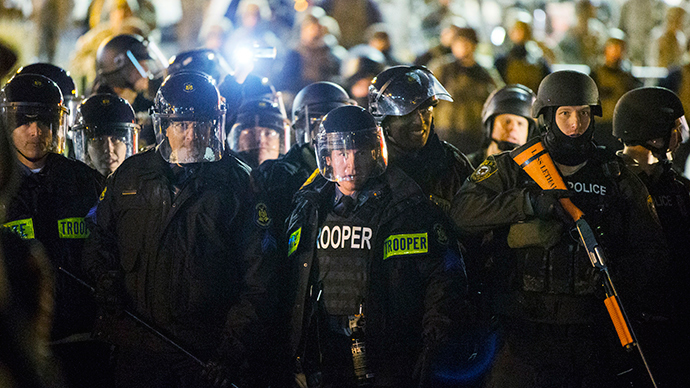Ferguson police training with ‘less lethal’ alternative bullets

Police in Ferguson, site of the fatal police shooting in August of unarmed black teenager Michael Brown, are testing a ‘less lethal’ handgun attachment that envelops a fired bullet in a ping-pong-ball-sized projectile for a blunted effect upon impact.
The Ferguson Police Department is currently testing the attachment -- known as the Alternative, made by California-based Alternative Ballistics -- for eventual use by all its 55 police officers, according to the Washington Post. The department is the first police agency in the US to test the $45-per-unit Alternative.
The Alternative is strong enough to knock someone to the ground or to break a bone, but it is not forceful enough to kill, even up close, according to Alternative Ballistics.
The device is attached to the end of a handgun barrel. When a bullet is discharged, a bullet-capture projectile is fired with it, traveling up to 250 feet per second when shot by a 9mm handgun.
“Hopefully we can get it on the streets soon,” said Ferguson assistant police chief, Al Eickhoff. “Is it going to work every time? Probably not . . . it’s not a catch-all. Every situation is different. But it gives an officer, if time allows -- and that’s important, if time allows -- a chance to save a life instead of taking a life.”
Christian Ellis, chief executive of Alternative Ballistics, called his new product, currently marketed in the US and abroad, “an air bag for a bullet.” The Alternative is designed, Ellis said, to send “a shock wave of pain through the suspect.”
Aiming to incapacitate a target, the Alternative would rarely penetrate the skin, Ellis said, based on close-range ballistics tests that were conducted using leather chamois, foam, and gel to simulate a human body.
#Ferguson PO's are training to use a device that is intended to make the first bullet discharged non-lethal. http://t.co/CGLOSe2060
— Legal Defense Fund (@NAACP_LDF) February 4, 2015
The Alternative does come with some drawbacks from a law enforcement perspective.
The attachment must be applied by an officer on the fly, possibly during high-stress incidents that demand a split-second decision over the use of force. The device will only catch the first bullet fired after application, so the next round will exit a gun unfettered. And while many people have tested the product, no human being has been shot with it, Ellis said.
READ MORE: 'Less-than-lethal' ammunition makers profiting off unrest from Ferguson to Israel
Opponents of less-than-lethal weaponry sit on either side of the use-of-force fence.
Some say the proliferation of such police gear may minimize deaths, but, as seen during the civil unrest in Ferguson that followed Brown’s death in August, police will ultimately use these tools to suppress dissent particularly in colored communities. And as US courts often side with law enforcement after fatal police shootings, and when no entity, even the US Department of Justice, keeps track of police shooting data, the deck is stacked against people who face law enforcement brutality on a regular basis.
“There’s always this understandable tendency to find any kind of weapons that will cause the least amount of harm to avoid deadly force,” said Chuck Wexler of the Police Executive Research Forum, adding that less-than-lethal weapons can still cause death, as Tasers have on many occasions.
“The intentions are good here,” Wexler said. “The problem is when the technology gets too far out and advanced and there are not policies or guidelines.”
Hmm. It's a nice idea and all, but what cop is going to stop in the heat of the moment to attach this thing to... http://t.co/U2OFxmbw8E
— I.V.Y. (@IvyVanessa79) February 4, 2015
On the other hand, law enforcement officers and their defenders worry an option like the Alternative will slow reaction time when use of force is needed to protect from injury or death.
Fumbling with the attachment “exposes police officers to greater risk” and “turns policy on its head,” said Steve Ijames, a former Missouri police major and training expert.
“I am all about less lethal,” he told the Post. “What bothers me is we will allow an officer to face immediate deadly jeopardy with a less-lethal round. Deadly force is the most likely thing to repel deadly force.”
So-called less-than-lethal munitions were often used on protesters in Ferguson in August and later months, when a grand jury decided not to indict white police officer, Darren Wilson, for Brown’s death.
On the ground, Ferguson protesters were subject to the use of tear gas, armored vehicles, rubber bullets packaged in cluster grenades, flash bangs, smoke bombs, sound cannons known as Long Range Acoustic Devices, bean bag guns, pepper spray, wooden batons, the presence of German shepherds, the issuance of a no-fly zone over the area, and darkness aided by night vision goggles, not to mention other violent threats made with firearms. All are billed as less lethal than outright firing bullets, yet they were no less daunting for a community seeking justice for Brown.
Eickhoff told the Post that, had Officer Wilson had the Alternative when he encountered Brown, there’s no guarantee Brown would have survived.
“You could still shoot him with this round,” Eickhoff said, “and he could still get up and come at you.”












